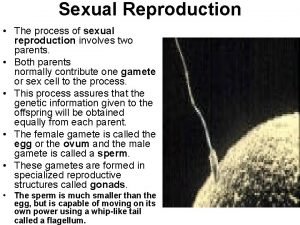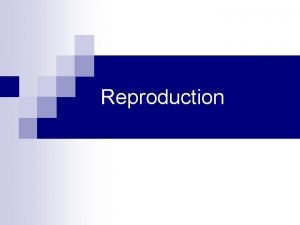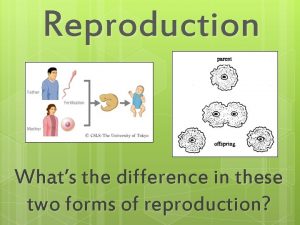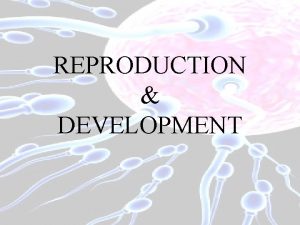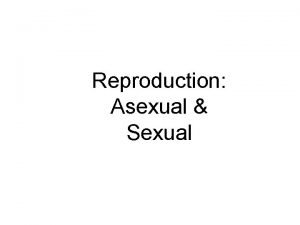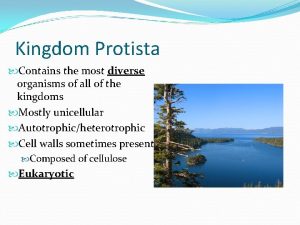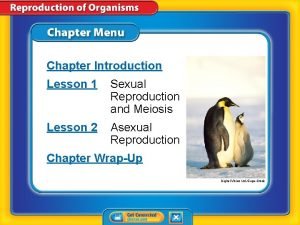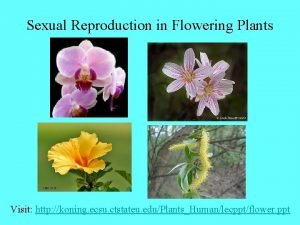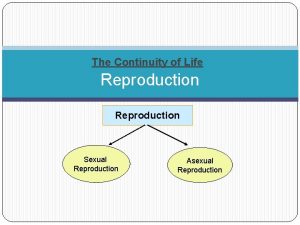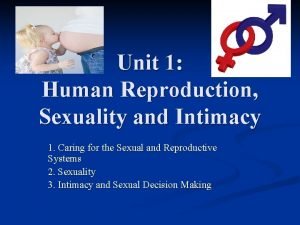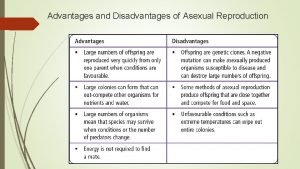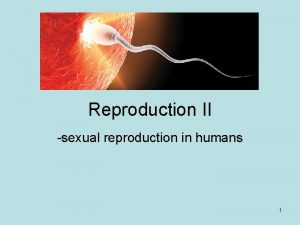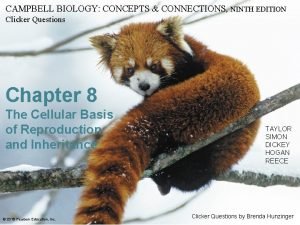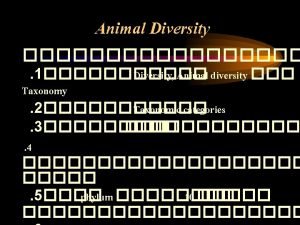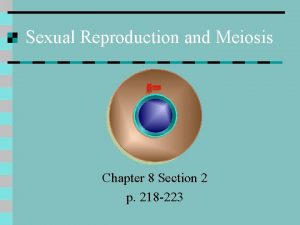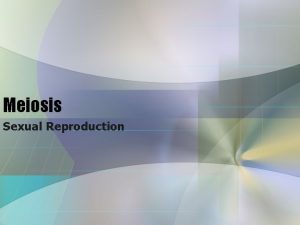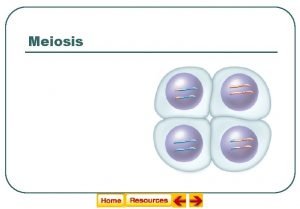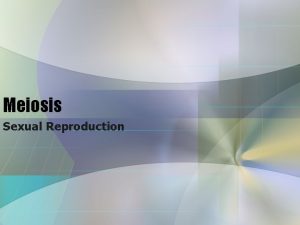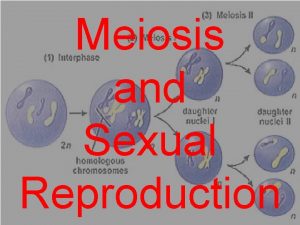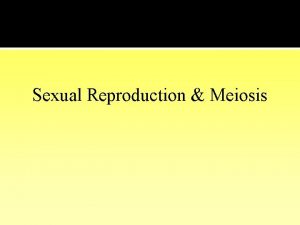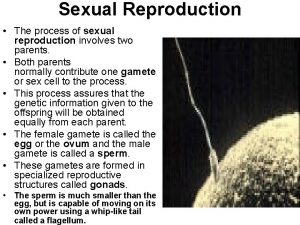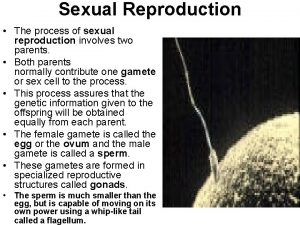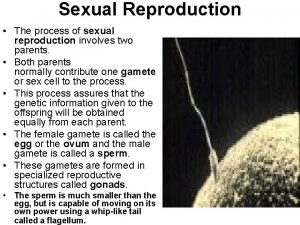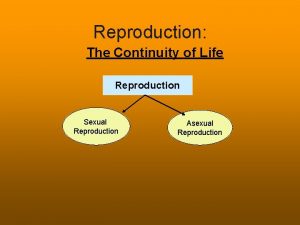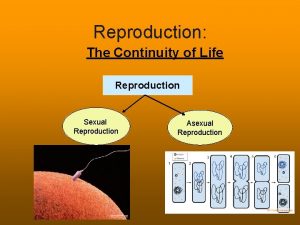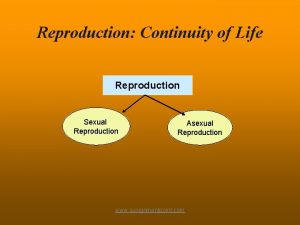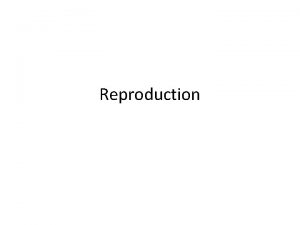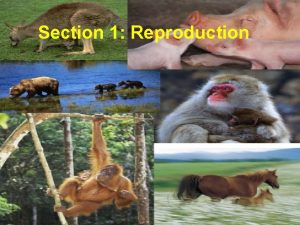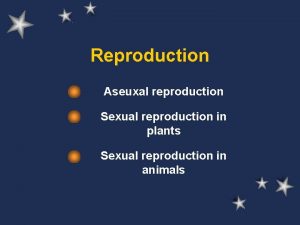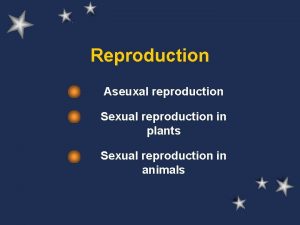Meiosis Reduction Division Meiosis Sexual reproduction involves continuity



























- Slides: 27

Meiosis Reduction Division

Meiosis Sexual reproduction involves continuity of biological traits from one generation to the next – HEREDITY p Offspring acquire traits from their parents p Each parent contributes ½ of the traits to their offspring p

Meiosis In meiosis the offspring are different from their parents and from each other p Meiosis occurs ONLY in the male and female gonads n Male – testes n Female - ovaries p

Asexual reproduction vs sexual reproduction p Asexual (mitosis) n n Single individual is sole parent Offspring genetically identical to the parent Results in a clone identical to parent Genetic differences occur rarely as a result of mutations p Sexual (meiosis) n n Two parents give rise to offspring Each parent contributes ½ of its genes to offspring Offspring are different from their parents Results in genetic variation in the form of mutations

Meiosis includes steps that closely resemble corresponding steps in mitosis p Like mitosis, meiosis is preceded by replication of chromosomes in interphase S stage p Meiosis differs from mitosis in that a single replication consists of two consecutive cell divisions called reduction division p These cell divisions produce 4 daughter cells instead of 2 as in mitosis p

Meiosis These 4 daughter cells have ½ the number of chromosomes as the original cells – they are called haploid (monoploid) p The 2 daughter cells of mitosis have the same number of chromosomes as the parent cell – they are called diploid p

1 st division Interphase p Chromosomes replicate -

Prophase 1 p Chromosomes condense to form chromatids

synapsis p homologous chromosomes pair resulting in a TETRAD (group of 4 similar chromatids)

Crossing over During synapsis in prophase I p Homologous chromosomes can exchange pieces resulting in more variation p

Crossing over p p p The chromosomes can wind around each other Chromosome pieces can break off and be reattached This creates unique gene combinations

Metaphase I p Tetrads line up on the metaphase plate at the equator

Anaphase I p The centromere splits and sister chromotids are pulled toward the poles

cytokinesis p Disjunction occurs – homologous pairs of chromosomes are separated by sister chromatids remain attached

cytokinesis p Results in 2 diploid cells

2 nd division The cells do not re-enter interphase p They go directly into prophase II p

Prophase II Centrioles move toward the poles p Spindle fibers re-form p

Metaphase II p Sister chromosomes line up at the equater

Anaphase II p Centromeres split and the sister chromatids are separated

Telophase p New nuclear membranes form and cytokinesis occurs for the 2 nd time

Result of meiosis 4 monoploid daughter cells p Each cell contains 1 of each chromosome p

http: //www. sumanasinc. com/webcontent/ animations/content/meiosis. html p http: //highered. mcgrawhill. com/sites/0072495855/student_view 0 /chapter 28/animation__how_meiosis_wor ks. html p http: //www. johnkyrk. com/meiosis. html p http: //www. cellsalive. com/meiosis. htm p

Comparison of mitosis and meiosis p Mitosis p Meiosis p Cytokinesis occurs 1 X 2 diploid daughter cells formed No synapsis or disjunction NO crossing over Occurs in all somatic body cells Daughter cells have same number of chromosomes as the parent cell p Cytokinesis occurs 2 X 4 monoploid gametes formed Synapsis occurs forming tetrads then disjunction Crossing over takes place Occurs only in gonads Gametes have ½ the normal chromosome number p p p p p

Oogenesis p p p The production of egg cells (ova) in the ovary of the female When the 1 st division takes place, the cytoplasm divided unequally One of the daughter cells receives most of the cytoplasm – the small cell is called the first polar body

Oogenesis p p During the 2 nd division, the cells divide unequally into 1 large ova and 2 polar bodies The ova must nourish the developing embryo until it implants in the uterus

Oogenesis p p The polar bodies break apart and die For each primary sex cell that undergoes meiotic division, there is only 1 ova produced

Spermatogenesis p p The production of sperm in the testes The sperm are produced by meiosis The division of the cytoplasm is equal For each primary sex cell there are 4 sperm produced
 Venn diagram of sexual and asexual reproduction
Venn diagram of sexual and asexual reproduction Sexual reproduction and asexual reproduction
Sexual reproduction and asexual reproduction Venn diagram of sexual and asexual reproduction in animals
Venn diagram of sexual and asexual reproduction in animals гаструла бластула
гаструла бластула Sexual reproduction and genetics section 1 meiosis
Sexual reproduction and genetics section 1 meiosis Chapter 10 section 3 gene linkage and polyploidy
Chapter 10 section 3 gene linkage and polyploidy Absolute continuity implies uniform continuity
Absolute continuity implies uniform continuity Internal fertilization
Internal fertilization Whats reproduction
Whats reproduction Asexual or sexual reproduction
Asexual or sexual reproduction Chapter 10 sexual reproduction and genetics
Chapter 10 sexual reproduction and genetics Asexual or sexual reproduction
Asexual or sexual reproduction Is mitosis asexual
Is mitosis asexual Anaphase meiosis vs mitosis
Anaphase meiosis vs mitosis The kingdom protista contains
The kingdom protista contains Connecting the concepts sexual reproduction
Connecting the concepts sexual reproduction Sexual reproduction
Sexual reproduction Sexual or asexual reproduction
Sexual or asexual reproduction Sexual reproduction in human
Sexual reproduction in human Disadvantages of sexual reproduction
Disadvantages of sexual reproduction What are the three groups of protists
What are the three groups of protists Reproduction
Reproduction Sexual reproduction
Sexual reproduction Chromosome number of animals
Chromosome number of animals Connecting the concepts sexual reproduction
Connecting the concepts sexual reproduction A sexual reproduction
A sexual reproduction Benefits of sexual propagation
Benefits of sexual propagation Sexual reproduction
Sexual reproduction



